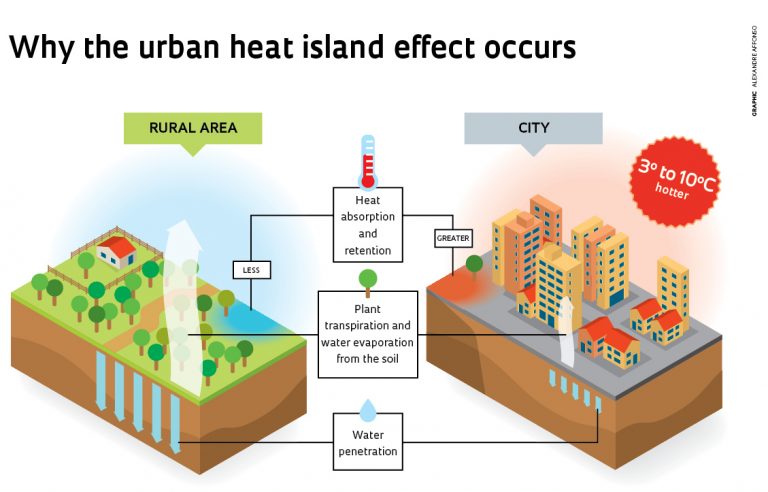
Introduction
Urban Heat Island Mitigation is a crucial topic in today’s rapidly urbanizing world. As cities grow, they absorb and radiate heat, creating localized heat islands that have adverse effects on human health, energy consumption, and the environment. This article provides an overview of Urban Heat Island Mitigation, its historical background, key concepts, and the main discussion points surrounding this issue.
Historical Background
The recognition of the urban heat island effect dates back to the early 19th century when cities started experiencing higher temperatures compared to their surrounding rural areas. Early attempts at mitigating urban heat islands involved modifying building materials and urban design. However, it was not until the mid-20th century that the scientific community began to understand the causes and impacts of this phenomenon. This led to the development of more effective approaches to mitigate urban heat islands.
Key Concepts and Definitions
To understand Urban Heat Island Mitigation, it is essential to grasp the key concepts and definitions associated with this issue. The Urban Heat Island (UHI) refers to the temperature difference between urban areas and their surrounding rural regions. Various factors contribute to UHI, such as the urban landscape, decreased vegetation cover, and the heat-absorbing properties of building materials. Urban Heat Island Mitigation encompasses strategies aimed at reducing UHI and its impacts. Key terms and concepts, such as albedo (the reflective properties of surfaces) and green infrastructure (vegetation and natural elements in urban areas), play a vital role in UHI mitigation.

Main Discussion Points
Urban Design Strategies for UHI Mitigation
Urban design strategies play a significant role in mitigating UHI. These strategies involve interventions that modify the built environment and its relationship with nature. Cool roofs, for example, use reflective materials to reduce the absorption of solar radiation and lower surface temperatures. Green spaces, such as parks and urban forests, provide shade and evaporative cooling. These urban design strategies have shown promising results in reducing UHI and improving urban livability.
Vegetation and Green Infrastructure as UHI Mitigation
Vegetation plays a crucial role in combating UHI. Urban areas with adequate green infrastructure, such as urban forests and green roofs, experience cooler temperatures due to the shading and evapotranspiration effects of vegetation. Green infrastructure also provides numerous co-benefits, including improved air quality, stormwater management, and biodiversity conservation. However, challenges such as limited space and maintenance requirements need to be considered when implementing green infrastructure projects.
Cool Materials and Technologies for UHI Mitigation
Cool materials, such as cool roofs and pavements, have gained attention as effective UHI mitigation strategies. These materials have high solar reflectance, reducing heat absorption and surface temperatures. Cool roofs and pavements can significantly contribute to reducing UHI and energy consumption in buildings. However, the potential impacts and limitations of cool materials, such as their durability and cost-effectiveness, need to be carefully evaluated before widespread implementation.

Case Studies or Examples
Case study: The Heat Island Reduction Program in New York City
The Heat Island Reduction Program in New York City aimed to reduce UHI through various strategies, including cool roofs, green roofs, and tree plantings. The program successfully demonstrated the effectiveness of these interventions in reducing UHI and improving the city’s overall sustainability. Implementation strategies, such as incentives and partnerships, played a crucial role in achieving positive results.
Case study: Singapore’s Garden City Approach
Singapore’s Garden City Approach is an exemplary model for UHI mitigation. The city-state has implemented various urban greening initiatives, including vertical greening and extensive tree planting. These efforts have not only reduced UHI but also enhanced the city’s aesthetics, biodiversity, and overall livability. However, challenges, such as limited land availability and managing competing urban priorities, remain significant considerations.
Current Trends or Developments
Advances in UHI research and monitoring technologies
Ongoing advancements in UHI research and monitoring technologies enhance our understanding of UHI dynamics and help identify effective mitigation strategies. Remote sensing techniques, urban heat island mapping, and high-resolution climate modeling contribute to developing more targeted and efficient UHI mitigation approaches.
Innovative approaches to UHI mitigation
Innovation in UHI mitigation includes the development of cool pavements, vertical greening systems, and smart technologies. Cool pavements utilize advanced materials to reduce surface temperatures, while vertical greening systems integrate plants into the built environment, providing multiple benefits. Smart technologies, such as sensor networks and data-driven urban planning, enable more precise UHI mitigation strategies.
Integration of UHI mitigation into urban planning policies and regulations
Cities worldwide are recognizing the importance of integrating UHI mitigation into urban planning policies and regulations. Incorporating UHI mitigation strategies into building codes, green space requirements, and development guidelines ensures long-term sustainability. Interdisciplinary collaborations between urban planners, architects, policymakers, and scientists are critical in achieving effective UHI mitigation outcomes.
Challenges or Controversies
Disagreements over the effectiveness of certain UHI mitigation strategies
While many UHI mitigation strategies have proven effective, there are ongoing debates regarding their long-term impacts and cost-effectiveness. It is crucial to evaluate the context-specific factors and adapt strategies accordingly to maximize their effectiveness.

Trade-offs and conflicts with other urban planning priorities
UHI mitigation strategies may sometimes conflict with other urban planning priorities, such as density and affordability. Balancing these priorities requires careful consideration and holistic approaches to ensure equitable and sustainable urban development.
Equity considerations in UHI mitigation efforts
UHI disproportionately affects vulnerable communities, exacerbating existing inequalities. UHI mitigation efforts must address these equity considerations by ensuring access to cool spaces, reducing heat-related health risks, and involving marginalized communities in decision-making processes.
Future Outlook
Potential impact of climate change on UHI and mitigation efforts
Climate change is expected to amplify UHI effects, making UHI mitigation even more critical. Rising temperatures and changing weather patterns necessitate innovative and adaptive UHI mitigation strategies to ensure urban resilience and human well-being.
Emerging technologies and strategies for UHI mitigation
Emerging technologies, such as green roofs with water retention capabilities and advanced cool materials, hold promise for effective UHI mitigation. Additionally, strategies like passive cooling techniques and nature-based solutions can contribute to sustainable urban development.
Importance of interdisciplinary collaborations for effective UHI mitigation
Addressing the complex challenges of UHI mitigation requires interdisciplinary collaborations between researchers, policymakers, urban planners, and community stakeholders. Collaborative efforts can facilitate knowledge exchange, innovative solutions, and the implementation of comprehensive UHI mitigation strategies.
Conclusion
Urban Heat Island Mitigation is a topic of significant relevance and importance for creating sustainable and livable cities. By understanding the historical background, key concepts, and main discussion points surrounding UHI mitigation, cities can implement effective strategies to combat UHI and its adverse impacts. Through interdisciplinary collaborations and innovative approaches, we can build resilient and equitable cities that prioritize human well-being and urban sustainability.




